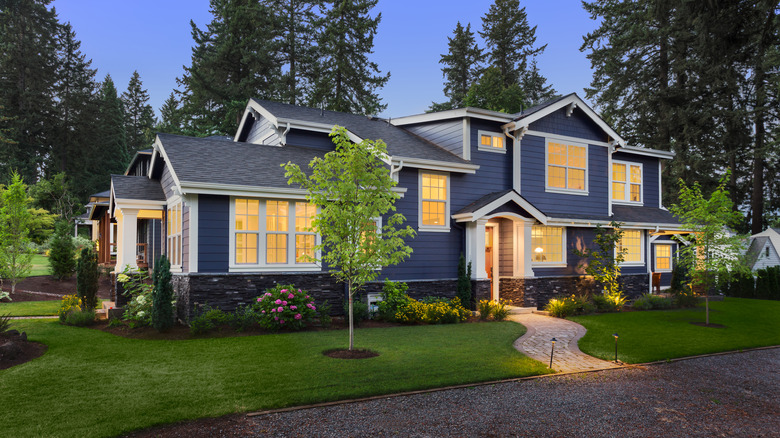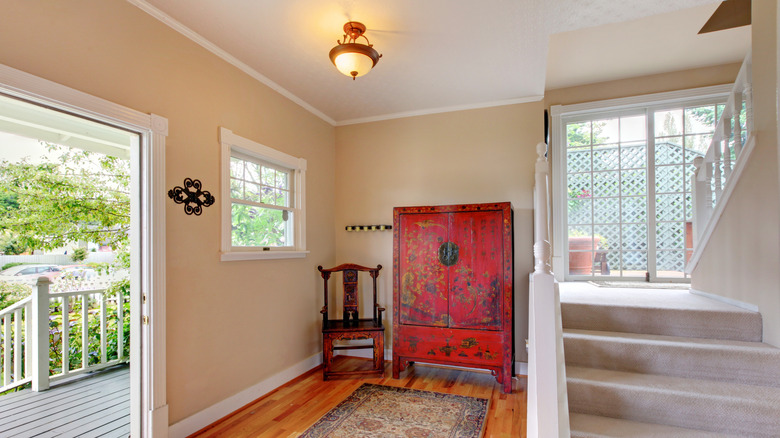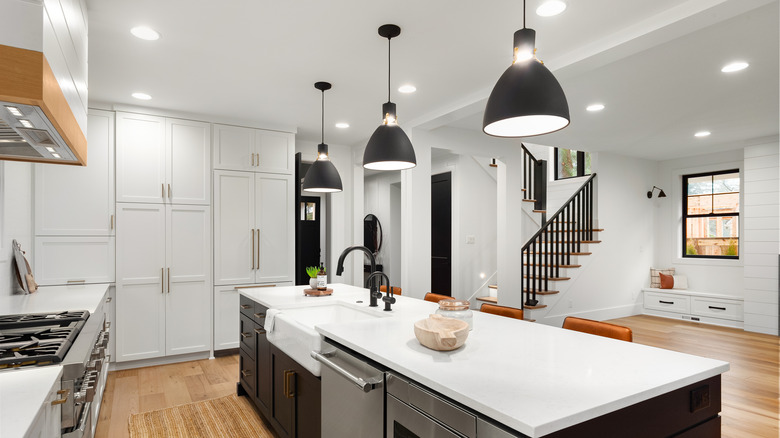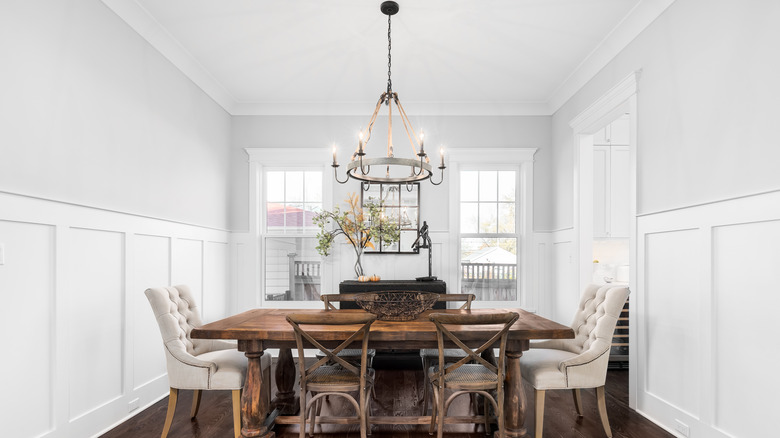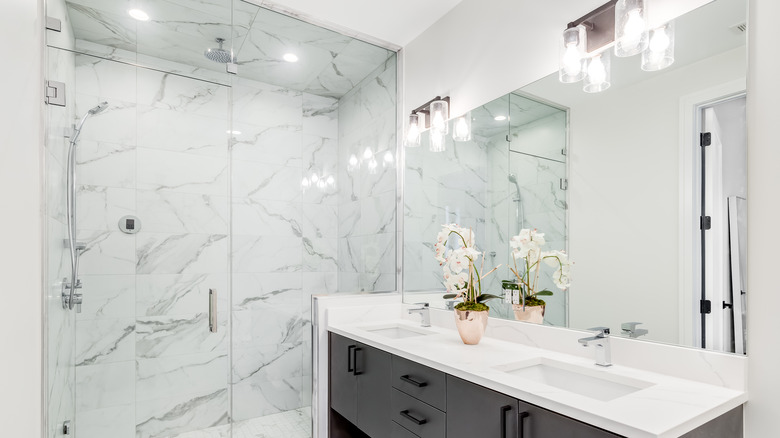5 Pointers For Selecting The Right Size Ceiling Light For Your Space
There are so many choices when it comes to ceiling lights! How can you choose one that will look right in your room? There are several categories of ceiling light fixtures, including chandeliers, pendant lights, and track lights along with flush and semi-flush mounted fixtures, explains Build With Ferguson. The best type of lighting for a particular room depends on how you will use that room, and the mood that you want to create.
Many of the rooms in our home are multi-functional. You may work from home at your dining room table and need different lighting than when you're hosting a meal. The same thing is true in guest rooms that double as an office, or bedrooms where someone might be studying. Each of these activities requires a different type of lighting, and so in many rooms, a combination of lighting is preferred. There are four main categories of lighting: ambient, task, accent, and decorative, notes Richporter Lighting.
Create a lighting plan
Ambient lighting adds an overall, general light to a room such as an entry, a hallway, or a bedroom. Task lighting is used for specific activities like reading, cooking, working in a workshop, or even being able to see up close in a bathroom mirror. Accent and decorative lighting are more design orientated and can be used to make a bold statement or as a way to draw attention to something (like artwork or a floral arrangement) by focusing light on it, suggests Lighting Research Centre.
We don't always think about a lighting plan when decorating our homes. If a room is too dark we add a light nearby. But, lighting sets the mood, allows for a variety of functions in each room, and accommodates the traffic patterns in a house. By selecting lighting intentionally, we can create a well-lit and safe environment, and prevent lights from being placed in a way that blocks site lines, or creates glare.
How big should a ceiling light be?
It's quite easy to choose a light fixture that's either too small for a room or much too big and elaborate. How can you choose the right fixtures for your rooms? Thankfully, there is a simple formula that will help you calculate the width of the ceiling fixture in relation to the size of your room. According to Lumens, measure the length and width of the room, for example, 14 feet by 17 feet. Add those two numbers together, in this case, 31 feet. Now, switch that measurement to inches, and you'll need a fixture with a diameter of 31 inches to provide adequate ambient lighting for that space.
This measurement is primarily used for flush- and semi-flush-mounted ceiling fixtures. A flush-mounted ceiling fixture has no space between the fixture frame and the ceiling, whereas a semi-flush-mounted fixture is suspended from a post a few inches from the ceiling (like the one pictured above.) In a long hallway, you may need to install a ceiling light every 4 to 6 feet to make sure the whole length is lit sufficiently. If you are going to work or study in a room, you'll want to add directional task lighting. This could be a desk light or a wall sconce with a swing arm.
How to choose pendant lights
Pendant lights have their own unique measurements. Over a kitchen island or a table that's over 6 feet in length, you could opt for a couple of larger pendant lights spaced 2 feet apart, writes Lights Online. For a balanced look, the width of the light fixture should be 12 inches less than the width of the furniture underneath. Pendants should ideally hang 28 to 34 inches above the furniture but make sure they won't cause glare, or interfere with the sight lines between people sitting and standing nearby. A smaller pendant light of 10 inches or less might work well above a kitchen sink. Hang it where it won't bump the head of the tallest person in your house, and won't block your view out of the kitchen window.
Pendant lights make a great substitute for bedside table lights because they won't take up any space on the night table. Some pendant lights can be plugged in, which is a plus if you don't want to break through the plaster to install a fixture, per Lumens. Hang them about 28 to 32 inches above the night table, depending on what works best for you.
Hanging chandeliers
If you're hanging a chandelier above a table, the recommended height is 30 to 36 inches above the table in a room with an 8-foot ceiling, explains Lights Online. For every foot extra of ceiling height, raise your chandelier up to 3 inches higher. Consider the style and visual impact of your light fixture. For instance, a very ornate chandelier may have a heavier appearance and might look better if it's hung at the higher end of the range, whereas a smaller, more compact chandelier might be more suitable at the lower end. So, before the final installation, have it held at different heights and stand back and decide what looks best.
For a chandelier in an entryway, the standard height is 7 feet from the floor to the bottom of the chandelier. For a taller ceiling, the range from the top of the ceiling to the bottom of the chandelier should be between 20 inches and 24 inches. A two-story height ceiling may require an additional chain or an extended rod to allow the fixture to be suspended at the right height, notes eHow. Remember to check it visually to see that the size and scale look good at that height.
When you need good lighting
Don't forget about good lighting in your dressing areas. It makes it much easier to get ready when you can see your clothes and tell navy from black. First, make sure to use an LED light bulb for fire safety, writes ProLighting, and keep it at least a foot away from things you have stored on a shelf. The color temperature of the bulb, which is measured in Kelvins (K) makes a difference in how clearly you'll see the colors of your clothes. Aim for a bulb with 3000 and 4000 K which is a clean, white light.
In your bathroom, you'll probably have a ceiling-mounted fixture as well as lights around the vanities. A vanity bar fixture with several lights should be centered above a vanity mirror, 75 to 80 inches above the floor, and at least 75% as wide as the mirror, according to Lights Online. Sconce lights placed on either side of a mirror should be hung at eye level, about 66 inches off the floor, and they should be 36 inches to 40 inches apart from one another. For an average-sized bathroom, choose sconces that are up to 18 inches tall, and in small bathrooms up to 12 inches tall.

